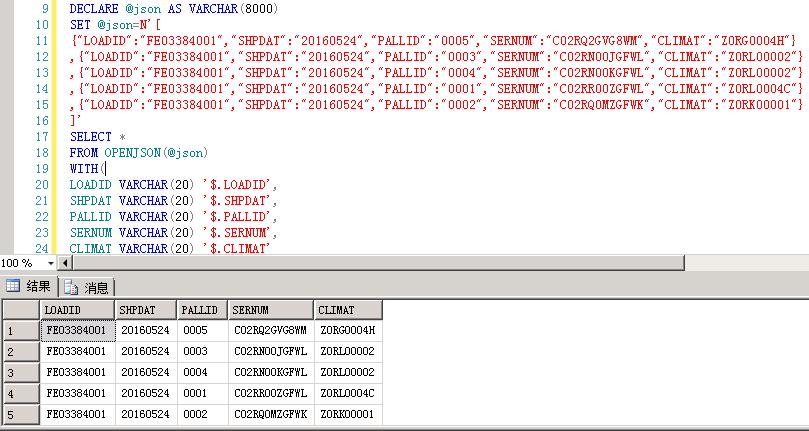SQL Server(00):JSON 函数
SQL Server 2005开始支持XML数据类型,提供原生的XML数据类型、XML索引及各种管理或输出XML格式的函数。
随着JSON的流行,SQL Server 2016开始支持JSON数据类型,不仅可以直接输出JSON格式的结果集,还能读取JSON格式的数据。
下面是我们熟悉的SELECT及输出格式,后面对JSON的演示基于此SQL:
一、 将查询结果输出JSON格式
1、FOR JSON AUTO:SELECT语句的结果以JSON输出。
要将SELECT语句的结果以JSON输出,最简单的方法是在后面加上FOR JSON AUTO:
2、FOR JSON AUTO,Root(’’) :为JOSN加上根节点
若要为FOR JSON加上Root Key,可以用ROOT选项来自定义ROOT 节点的名称:
3、FOR JSON PATH输出:可通过列别名来定义JSON对象的层次结构
若要自定义输出JSON格式的结构时,必须使用JSONPATH。
- FOR JSON Auto,自动按照查询语句中使用的表结构来创建嵌套的JSON子数组,类似于For Xml Auto特性。
- FOR JSON Path,通过列名或者列别名来定义JSON对象的层次结构,列别名中可以包含“.”,JSON的成员层次结构将会与别名中的层次结构保持一致。
这个特性非常类似于早期SQL Server版本中的For Xml Path子句,可以使用斜线来定义xml的层次结构。
4、FOR JSON PATH+ROOT输出:为JOSN加上根节点
5、INCLUDE_NULL_VALUES:值null的字段需要显示出现。
为NULL的数据在输出JSON时,会被忽略,若想要让NULL的字段也显示出来,可以加上选项INCLUDE_NULL_VALUES,该选项也适用于AUTO。
6、列的别名,可以增加带有层级关系的节点。
比如下面的SQL,增加了一个“SN”节点,把栏位SERNUM和CLIMAT放在里面:
演示实例:
select TOP (2) id, Plies, Createtime from [dbo].[B3PliesData] ORDER BY ID ; --1178 3 2020-07-21 14:33:18.480 --1179 3 2020-07-21 14:36:27.457 select TOP (2) id, Plies as [myObject.Plies], Createtime as [myObject.Createtime] from [dbo].[B3PliesData] ORDER BY ID for json auto; --[{"id":1178,"myObject.Plies":3,"myObject.Createtime":"2020-07-21T14:33:18.480"},{"id":1179,"myObject.Plies":3,"myObject.Createtime":"2020-07-21T14:36:27.457"}] select TOP (2) id, Plies, Createtime from [dbo].[B3PliesData] ORDER BY ID for json auto ,root('myRoot') ; --{"myRoot":[{"id":1178,"Plies":3,"Createtime":"2020-07-21T14:33:18.480"},{"id":1179,"Plies":3,"Createtime":"2020-07-21T14:36:27.457"}]} select TOP (2) id, Plies as [myObject.Plies], Createtime as [myObject.Createtime] from [dbo].[B3PliesData] ORDER BY ID for json path; --[{"id":1178,"myObject":{"Plies":3,"Createtime":"2020-07-21T14:33:18.480"}},{"id":1179,"myObject":{"Plies":3,"Createtime":"2020-07-21T14:36:27.457"}}] select TOP (2) id, Plies, Createtime,null as mynull from [dbo].[B3PliesData] ORDER BY ID for json path,root('myRoot'); --{"myRoot":[{"id":1178,"Plies":3,"Createtime":"2020-07-21T14:33:18.480"},{"id":1179,"Plies":3,"Createtime":"2020-07-21T14:36:27.457"}]} select TOP (2) id, Plies, Createtime,null as mynull from [dbo].[B3PliesData] ORDER BY ID for json path,root('myRoot'),include_null_values; --{"myRoot":[{"id":1178,"Plies":3,"Createtime":"2020-07-21T14:33:18.480","mynull":null},{"id":1179,"Plies":3,"Createtime":"2020-07-21T14:36:27.457","mynull":null}]}
二、 解析JSON格式的数据
1、使用OPENJSON()函数:
2、通过WITH选项,自定义输出列:
实例演示:
-------------1、------------- declare @json as varchar(8000) set @json='[ {"id":1178,"myObject.Plies":3,"myObject.Createtime":"2020-07-21T14:33:18.480"}, {"id":1179,"myObject.Plies":3,"myObject.Createtime":"2020-07-21T14:36:27.457"}]' select * from openjson(@json); --key value type --0 {"id":1178,"myObject.Plies":3,"myObject.Createtime":"2020-07-21T14:33:18.480"} 5 --1 {"id":1179,"myObject.Plies":3,"myObject.Createtime":"2020-07-21T14:36:27.457"} 5 -------------2、------------- declare @json1 as varchar(8000) set @json1='[ {"id":1178,"myObject.Plies":3,"myObject.Createtime":"2020-07-21T14:33:18.480"}, {"id":1179,"myObject.Plies":3,"myObject.Createtime":"2020-07-21T14:36:27.457"}] ' select * from openjson(@json1) with( id varchar(10) '$.id', Plies int '$."myObject.Plies"', Createtime datetime '$."myObject.Createtime"' ); --id Plies Createtime --1178 3 2020-07-21 14:33:18.480 --1179 3 2020-07-21 14:36:27.457 -------------3、------------- declare @json2 as varchar(8000) set @json2='{"myRoot":[ {"id":1178,"myObject":{"Plies":3,"Createtime":"2020-07-21T14:33:18.480"}}, {"id":1179,"myObject":{"Plies":3,"Createtime":"2020-07-21T14:36:27.457"}} ]}' select * from openjson(@json2,'$.myRoot') with( id varchar(10) , Plies int '$.myObject.Plies', Createtime datetime '$.myObject.Createtime' ); --id Plies Createtime --1178 3 2020-07-21 14:33:18.480 --1179 3 2020-07-21 14:36:27.457
三、JSON函数
declare @param nvarchar(max); set @param = N'{ "info":{ "type":1, "address":{ "town":"Bristol", "county":"Avon", "country":"England" }, "tags":["Sport", "Water polo"] }, "type":"Basic" }';
1、ISJSON:测试字符串是否包含有效 JSON。
print iif(isjson(@param) > 0, 'OK', 'NO');
返回:OK
2、JSON_VALUE :从 JSON 字符串中提取标量值。
print json_value(@param, '$.info.address.town'); print json_value(@param, '$.info.tags[1]');
返回:Bristol,Water polo
3、JSON_QUERY :从 JSON 字符串中提取对象或数组。返回类型为 nvarchar(max) 的 JSON 片段
print json_query(@param, '$.info');
{
"type":1,
"address":{
"town":"Bristol",
"county":"Avon",
"country":"England"
},
"tags":["Sport", "Water polo"]
}
4、JSON_MODIFY :更新 JSON 字符串中属性的值,并返回已更新的 JSON 字符串。
print json_modify(@param, '$.info.address.town', 'London');
返回:
{
"info":{
"type":1,
"address":{
"town":"London",
"county":"Avon",
"country":"England"
},
"tags":["Sport", "Water polo"]
},
"type":"Basic"
}
实例演示:
declare @param nvarchar(max); set @param=N'{ "info":{ "type":1, "address":{ "town":"Bristol", "county":"Avon", "country":"England" }, "tags":["Sport", "Water polo"] }, "type":"Basic" }'; print iif(isjson(@param)>0, 'OK', 'NO'); print json_query(@param); print json_value(@param, '$.info.address.town'); print json_value(@param, '$.info.tags[1]'); print json_query(@param, '$.info'); print json_query('["2020-1-8","2020-1-9"]'); print json_modify(@param, '$.info.address.town', 'London');
四、注意事项
SQL2016 中的新增的内置JSON进行了简单介绍,主要有如下要点:
- JSON能在SQLServer2016中高效的使用,但是JSON并不是原生数据类型;
- 如果使用JSON格式必须为输出结果是表达式的提供别名;
- JSON_VALUE 和 JSON_QUERY 函数转移和获取Varchar格式的数据,因此必须将数据转译成你需要的类型。
- 在计算列的帮助下查询JSON可以使用索引进行优化。
posted on 2018-11-30 10:48 springsnow 阅读(4384) 评论(0) 编辑 收藏 举报











